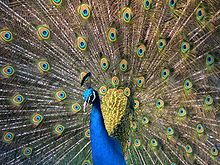Predation risk
As predation risk (of Latin praedare begin =, rob, plunder) refers to the risk of species of predators to be taken up.
Animals have produced various adaptations over the course of their tribal history that reduce their risk of predation. This includes, for example, camouflage , but also the development of effective defense mechanisms ( e.g. military secretion , horns ) and behavioral adaptations ( rigidity ).
In connection with the risk of predation, the cause of the formation of conspicuous ornaments is often discussed. For example, the long tail of the male peacock increases its risk of predation. In accordance with the handicap principle , however, it signals to females and competitors that it is viable despite this restriction; his chance of reproduction increases precisely because he has a higher risk of predation.
